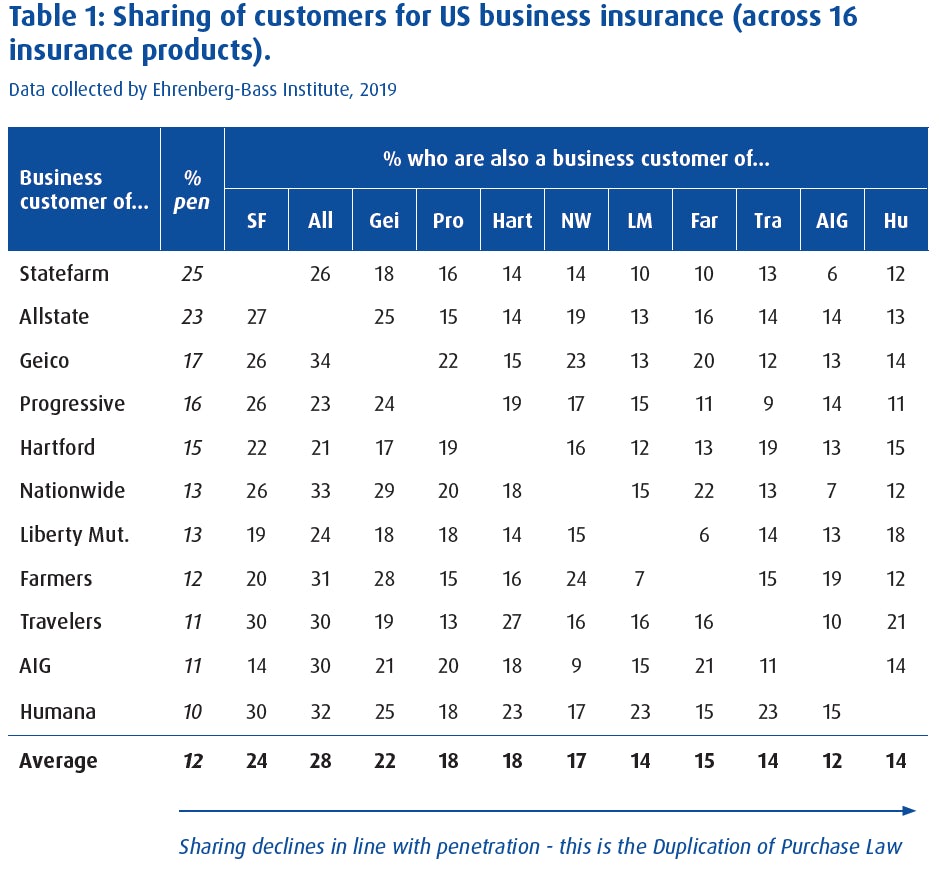Ehrenberg-Bass: Narrow targeting ‘counter-productive’ to B2B growth
Length: • 4 mins
Annotated by Emre Doganer

For a B2B marketer looking to acquire new customers and drive business growth, it might seem common sense to target a niche group of customers whose needs directly align with the product or service on offer.
However, according to a major new study by Ehrenberg-Bass Institute’s Professor Jenni Romaniuk for the LinkedIn B2B Institute, that’s a “counter-productive” approach. The best way to drive B2B business growth is to target all customers within the brand’s category.
Professor Romaniuk’s study confirms that the marketing law of duplicate purchase applies to B2B markets just as much as it applies to B2C. This means B2B brands share customers with and acquire customers from all other brands in their market, proportional to competitor share.
Building on previous research, Professor Romaniuk observes the duplication of purchase law taking effect across the US business insurance market, as seen in the table below.
Covering 16 different business insurance products, including commercial auto insurance, crime coverage, business income interruption insurance, travel insurance and professional liability insurance, the data shows how customer sharing declines in line with brand penetration.

On average, 24% of customers at any company in the market will also have a policy with Statefarm, the insurance business with the highest penetration. At the other end of the scale, just 14% of a company’s customers will be shared with Humana, the business with the lowest penetration.
“The duplication of purchase law tells us how we compete with other brands in the competitive market,” Romaniuk explains to Marketing Week.
“What it tells us is that it doesn’t so much matter what our positioning is, or what products we sell. If we’re competing in a market with a brand, then how they are as a competitor is really related to their size. We will share more of our customers with bigger competitors and fewer of our customers with smaller competitors.”
According to Romaniuk, the law holds true for both subscription markets, where a customer buys from one brand at a time, and multi-brand markets, where a customer may buy from more than one brand simultaneously. Previous research has shown that the duplication of purchase law applies to B2B goods as well as services.
The duplication of purchase law can also be observed in defection and acquisition patterns over time, as Romaniuk demonstrates across the UK business banking market. Customers in the market were asked which bank is their main financial institution (MFI) now and which bank was their MFI a year prior.
As seen in the table below, banks of every size saw more of their MFI customers defect to bigger banks and fewer defect to medium and smaller banks.

As such, new customers to a B2B brand will most likely come from the bigger brands in the market, while fewer will come from the smaller brands.
“That immediately tells you about your media strategy and who you should be concerned about if they’re growing – because obviously if you decline, that’s where your customers will go. It really puts the whole market structure into place,” Romaniuk adds.
She explains that small brands, even those that look similar to your own company or brand, are typically minor competitors. It’s the bigger brands that B2B marketers need to be keeping an eye on, as their marketing activities could have a much greater impact on their own firm’s bottom line.
Abiding the law
According to the law of double jeopardy, as Romaniuk demonstrated in a B2B context, the only viable way for brands to grow is through customer acquisition. Expanding a brand’s customer base is therefore essential.
Combining this knowledge with that of the duplicate purchase law shows that no matter how niche your product or positioning, the most efficient way to grow your B2B brand is by using your marketing efforts to reach your entire market.
Narrow targeting methods are “counter-productive”, Romaniuk argues, adding that the return on acquisition for targeting the customers of smaller competitors typically delivers lower returns.
Peter Weinberg, one of two global leads at the LinkedIn B2B Institute, adds that segmentation and targeting is where he has seen a lot of B2B brands fall down.
“Ultimately you want to target anyone who buys your category, not just some niche segment you think your brand can own,” he advises.
Jon Lombardo, the LinkedIn B2B Institute’s second global lead, notes the marketing industry has been moving to “narrower and narrower” ideas over recent years, initially with lead generation, now with account-based marketing (ABM).
“Effectively the segmentation is now down to the individual, and there’s never enough scale in trying to do things at that level,” he argues. “The trend has been to go smaller and smaller and smaller, and there’s no evidence that smaller and smaller works.”
Ultimately you want to target anyone who buys your category, not just some niche segment that you think your brand can own.
Peter Weinberg, LinkedIn B2B Institute
Where marketers do opt for broad reach marketing, effective branding becomes particularly important to ensure that any attention from customers is correctly attributed, Romaniuk advises. She also recommends employing marketing activities that create and refresh “mental structures” relevant to mental and physical availability.
Moreover, Weinberg points out that the implications of duplicate purchase on brand measurement are “somewhat profound”, as it forces small brands to acknowledge they are competing against the biggest brands in the category, not the smallest.
He continues: “So marketers may be flattering themselves by only comparing themselves to companies of a similar size but ultimately they need to grow by stealing share from much bigger competitors.”